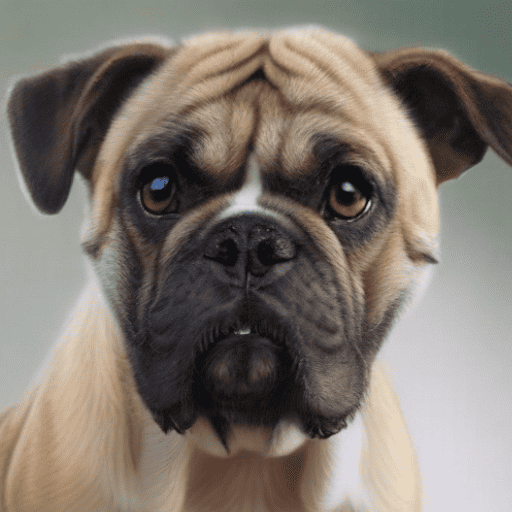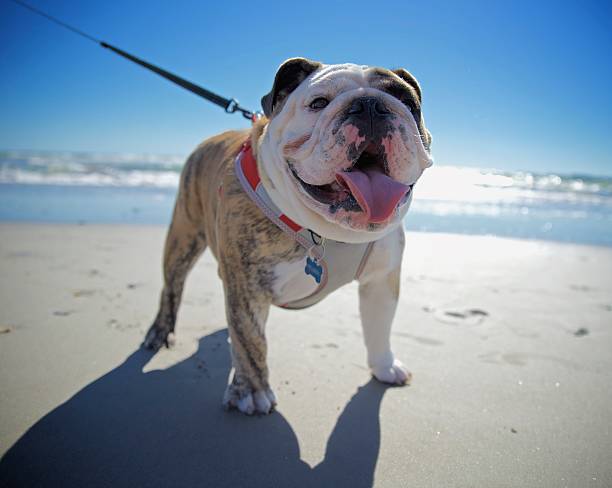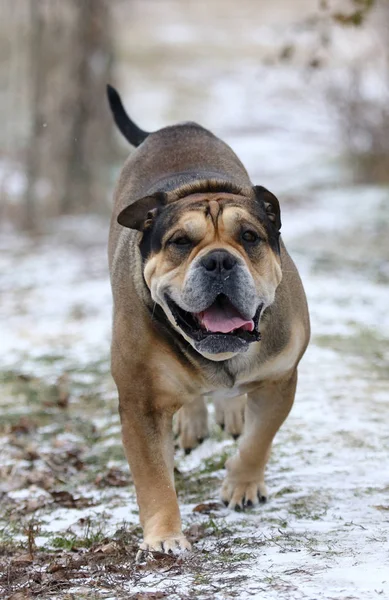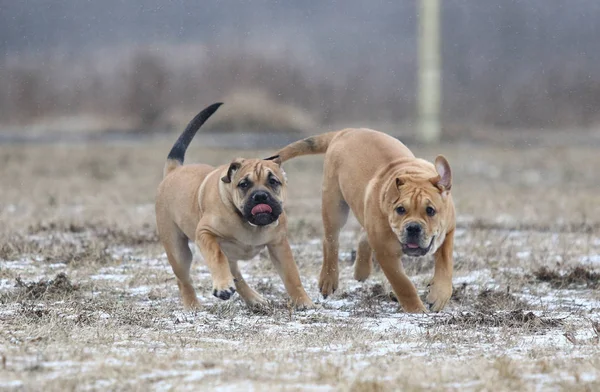The Ca de Bou, also known as the Mallorquin Bulldog, is a breed that resonates deeply with those who value strength, loyalty, and a distinctive presence. With its rich history, robust physique, and unwavering courage, this breed has earned its place as a cherished protector and a tribute to its Mallorcan roots.

| Category (Explanation) | Breed Information |
|---|---|
| Year of Breed Conception | 17th century |
| Country of Origin | Spain (Mallorca) |
| Weight (Male) | 75-105 lbs (34-48 kg) |
| Weight (Female) | 66-88 lbs (30-40 kg) |
| Coat Type | Short, dense |
| Color Variations | Brindle or fawn |
| Shedding Level | Low to moderate |
| Height (cm & in) | 22-24 inches (56-61 cm) |
| Breed Size | Large |
| Trainability | Moderate |
| Mental Needs | Moderate |
| Intelligence Level | Moderate |
| Energy Level | Moderate to high |
| Agility | Moderate |
| Loyalty | High |
| Playfulness | Moderate to high |
| Exercise Needs | Regular exercise and mental stimulation |
| Guarding Proficiency | High |
| Sociability with Children | Moderate |
| Barking Level | Moderate |
| Digging Tendency | Moderate |
| Destructive Behavior | Low to moderate |
| Drooling Level | Moderate to high |
| Obedience Level | Moderate |
| Apartment Friendly | Yes, with proper exercise and mental stimulation |
| Inherent Prey Drive | Moderate |
| Physical Risk to Others | Low to moderate |
| Travel Fatality Risk | Low |
| Allergen Potential | Low (considered hypoallergenic) |
| Health Concerns | Hip dysplasia, gastric torsion |
| Average Life Expectancy | 10-12 years |











































































Woof Mastery is reader supported and our articles may contain affiliate links.
Instead of running third party ads that we have no control of we only use links from high-quality companies we are directly partnered with. Making use of these links come at no cost to you our reader, and in many cases have the extra benefit of discounted rates or sign up bonuses.
If you’re interested you can read more about our affiliate policy here.
We appreciate your support and always insure that the products and services we recommend are high-quality, helpful and relevant to the subject at hand!
The Ca de Bou, also known as the Mallorquin Bulldog, boasts a history that unfolds on the picturesque island of Mallorca, Spain. Originating from the crossbreeding of native Mallorquin dogs with Bulldogs brought by the British during the 18th century, this breed was initially used for bull-baiting and guarding. Over time, their role transitioned to that of loyal family protectors. Ca de Bou dogs are known for their impressive strength, loyalty, and calm demeanor.
They are an embodiment of Mallorquin heritage and continue to serve as steadfast companions, symbolizing the resilience and charm of the Mediterranean island.

What sets the Ca de Bou, or Mallorquin Bulldog, apart is its strong and fearless character. Originating from the Balearic Islands, these dogs are known for their determination and protective instincts. Ca de Bous balance their powerful appearance with a deep sense of loyalty to their families, making them unique and dependable guardians.
Their traditional roles included working on farms, guarding, and hunting, but they have become adaptable and loyal family dogs.
Ca de Bou dogs are renowned for their loyal and protective nature. They are known to be affectionate with their families and possess an innate intelligence that makes them responsive to training.
These dogs have a robust and powerful appearance but can be remarkably gentle and loving with those they hold dear. Ca de Bou dogs are the kind of loyal protectors who have a soft spot for their loved ones. They can form incredibly close bonds with their family members, displaying a sense of devotion that is unwavering.
While they may display some reserve around strangers, this is often a sign of their protective instincts, as they take their role as guardians seriously. Their loyalty is profound, and once they consider someone as part of their pack, they become deeply committed to their well-being. Ca de Bou dogs epitomize a unique blend of strength and affection in their personality, embodying both the protector and the gentle giant.
Ca de Bou, or Mallorquin Bulldogs, often possess a loyal and protective temperament. They may display affection towards their families, but protective instincts can surface and require attention through training and socialization to avoid overprotectiveness or aggression towards strangers. Territorial behavior and occasional stubbornness may arise, emphasizing the importance of consistent and patient training.
Due to their strength, leash training is crucial. Careful introductions are recommended when interacting with other dogs, especially those of the same sex. Early training and socialization are fundamental for nurturing a well-adjusted and balanced temperament in this breed.
Ca de Bou, also known as the Mallorquin Bulldog, is a medium to large-sized breed recognized for its muscular and compact build. They feature a square-shaped head with a broad, well-defined jaw and strong cheeks, giving them a formidable appearance.
Their eyes are typically brown and convey a watchful expression. Ears can be cropped or natural, depending on preference. These dogs have a short, dense coat, often seen in shades of fawn or brindle. The coat highlights their muscular physique.
Also, Ca de Bou boasts a powerful, muscular neck, leading to a broad chest and sturdy, straight legs. Their tail is usually straight.
In terms of size, males stand between 21 to 24 inches (53-61 cm) at the shoulder, while females are slightly smaller. Weight ranges from 75 to 110 pounds (34-50 kg) for males, with females being lighter.
Overall, the Ca de Bou possesses a robust and imposing presence, reflecting their history as versatile working dogs and guardians. Their appearance exudes strength, confidence, and a loyal temperament.
Ca de Bou, also known as the Mallorquin Bulldog, has a powerful and distinctive appearance with the following color varieties:
Ca de Bou, also known as Mallorquin Bulldogs, have a low shedding level. They are not heavy shedders, and their shedding is generally minimal year-round. Occasional grooming and brushing with a soft bristle brush can help control shedding and maintain their coat’s health.
Factors influencing shedding in Ca de Bou may include genetics and climate. Providing protection from extreme temperatures and ensuring a balanced diet can help minimize shedding. Regular grooming is essential for coat care and shedding control.
Ca de Bou Bulldogs are known for their short, rough coat.
Brushing: Despite the rustic appearance, brushing them with a medium-bristle brush weekly ensures the removal of dead hairs, keeping the coat looking its best.
Bathing: Bathing every 6-8 weeks or when they get particularly dirty will help maintain a healthy skin and coat. A hypoallergenic dog shampoo is advisable as they can have sensitive skin.
Ears: Due to their slightly pendulous ears, weekly cleaning is crucial. This helps to prevent moisture accumulation and potential ear infections.
Nails: Ensure nails are trimmed bi-weekly, as overgrown nails can cause pain and lead to posture issues.
Teeth: Dental care is pivotal. Regular brushing with dog-specific toothpaste, along with dental treats, can help in maintaining good oral health.
Wrinkle Care: While they’re not overly wrinkled, their distinctive head and muzzle have some folds. It’s essential to keep these areas clean and dry, checking them several times a week.
Eye Care: Their soulful eyes can sometimes have minor discharges. Clean around the eye area using a soft cloth dipped in warm water.
Ca de Bou, also known as the Mallorquin Bulldog, has a moderate activity level. They are known for their loyalty and protective instincts. Here are some key points to consider about their activity level:
Ca de Bou, also known as the Mallorquin Bulldog, exhibits a moderate level of intelligence. Their intelligence is marked by adaptability, problem-solving abilities, and a strong desire to please their owners. Here are some key points about their intelligence:
While Ca de Bou (Mallorquin Bulldog) may not be widely known for their intelligence, their unique combination of adaptability, problem-solving skills, and loyalty to their owners make them excellent working and companion dogs. Training, socialization, and mental stimulation are essential to help them reach their full potential.
Ca de Bous appreciate engaging mind challenges. Activities such as hide-and-seek with toys, tracking games, or training drills keep them intrigued.
Social Interaction: Their protective nature demands regular bonding sessions with family. Extended solitude can manifest as behavioral issues, so frequent interactions are key.
Exercise: Beyond their muscular frame, physical activities significantly benefit their mental framework. Consistent workouts, be it brisk walks or play sessions, are essential.
Training and Obedience: Ca de Bous respond well to structured training that taps into their natural guarding instincts. Training using positive methods fosters mutual respect.
Routine and Structure: Being creatures of habit, a well-defined daily structure provides them solace and diminishes anxiety.
Affection and Attention: While they may seem stoic, they need consistent affection and quality moments with their caregivers to thrive.
Socialization: For their protective instincts to be well-balanced, early exposure to varied settings and creatures is crucial.
Safe Environment: Ensure they have a tranquil spot at home, allowing them moments of respite and reflection when needed.
Consistency: Maintaining a consistent routine, especially in training, amplifies their sense of security and belonging.
Enter The Woof Mastery

Prior to bringing a Ca de Bou (Mallorquin Bulldog) into your home, it’s important to recognize their specific needs. These dogs are known for their courageous and independent nature. They require regular exercise and mental stimulation to maintain their well-being. Training and socialization are important to ensure they are well-behaved.
Be aware of potential health concerns specific to the breed, including joint issues. Responsible ownership includes being prepared for grooming and providing a secure and loving environment for these loyal and determined companions.
Ca de Bou, or Mallorquin Bulldogs, with their strong guarding instincts, have the potential to pose a physical danger if they are not appropriately socialized, trained, or managed. A dog’s behavior largely hinges on factors like temperament, upbringing, training, and owner involvement. Here’s their potential danger breakdown:
Ca de Bou dogs are renowned for their loyal and protective nature. They are known to be affectionate with their families and possess an innate intelligence that makes them responsive to training.
These dogs have a robust and powerful appearance but can be remarkably gentle and loving with those they hold dear. Ca de Bou dogs are the kind of loyal protectors who have a soft spot for their loved ones. They can form incredibly close bonds with their family members, displaying a sense of devotion that is unwavering.
While they may display some reserve around strangers, this is often a sign of their protective instincts, as they take their role as guardians seriously. Their loyalty is profound, and once they consider someone as part of their pack, they become deeply committed to their well-being. Ca de Bou dogs epitomize a unique blend of strength and affection in their personality, embodying both the protector and the gentle giant.
Ca de Bou or the Mallorquin Bulldog, a rare breed from the Spanish island of Mallorca, possesses certain traits that influence their relationship with water. Here’s what to consider:
While some Ca de Bou might enjoy water and manage to swim, it’s essential to prioritize safety and be attuned to their comfort levels.
Ca de Bous, as with other canine breeds, have a set of vocalizations they utilize for communication. Here’s what to expect:
Understanding the range and context of the vocalizations of a Ca de Bou is essential for owners. While many sounds are simply expressive, others could signify specific needs or discomfort. Positive reinforcement techniques can assist in managing any excessive vocal tendencies.
Ca de Bou, also known as the Mallorquin Bulldog, thrives in homes where they receive love, structure, and opportunities for socialization. Here are some ideal living conditions for Ca de Bou:
Challenges:
When it comes to travel fatality risk for Ca de Bous, consider the following potential constraints:
By keeping these in mind, traveling with your Ca de Bou can be much safer.
Ca de Bous may be prone to specific health concerns. While not all individuals will experience these issues, it’s essential for Ca de Bou owners to be aware of potential health problems and work with veterinarians to maintain their pets’ well-being. Common health concerns in Ca de Bous include:
Regular veterinary check-ups, a balanced diet, proper exercise, and responsible breeding practices can help mitigate some of these health concerns. It’s crucial for Ca de Bou owners to work closely with their veterinarians to monitor their pets’ health and address any issues promptly.
Proper nutrition is essential for the health and well-being of Ca de Bou, also known as the Mallorquin Bulldog. Here are some nutritional habits and best practices tailored to this breed:
Breed-Specific Laws (BSL): Ca de Bou, or the Mallorquin Bulldog, might be subject to breed-specific laws (BSL) in certain localities. These laws usually differ by jurisdiction and are most often determined at the municipal level.
Types of Restrictions: Restrictions concerning Ca de Bou under BSL might involve mandatory spaying/neutering, specialized licensing, liability insurance obligations, provisions for muzzling in public zones, and occasionally, restrictions on ownership, depending on regional regulations.
Rationale for BSL: These laws often arise from concerns over the safety implications of certain breeds, especially if they have been involved in any incidents. The Ca de Bou, with its strong and protective nature, can sometimes be misunderstood and thus affected by BSL.
Controversy: BSL is a topic of debate, with critics emphasizing the importance of individual behavior over breed-specific generalizations and advocating for a focus on responsible pet ownership.
Local Regulations: Prior to obtaining a Ca de Bou, it’s advisable to check with local authorities or animal control to ensure an understanding of any breed-specific regulations in place.
Woof Mastery is reader supported and our articles may contain affiliate links.
Instead of running third party ads that we have no control of we only use links from high-quality companies we are directly partnered with. Making use of these links come at no cost to you our reader, and in many cases have the extra benefit of discounted rates or sign up bonuses.
If you’re interested you can read more about our affiliate policy here.
We appreciate your support and always insure that the products and services we recommend are high-quality, helpful and relevant to the subject at hand!
Myth 1: Ca de Bou (Mallorquin Bulldogs) are Aggressive by Nature
Myth 2: They are High-Energy Dogs
Myth 3: They Can’t Tolerate Cold Weather
Myth 4: They are Not Good with Children
Myth 5: They Shed Excessively
Myth 6: They Don’t Require Training.
Myth 7: They are Always Good with Other Dogs
Myth 8: They Are All the Same Size
Myth 9: They are Unhealthy Dogs
Myth 10: They are Always Clingy
The Ca de Bou (Mallorquin Bulldog) holds cultural significance in various contexts:
While there may not be as many famous Ca de Bou owners as there are for other dog breeds, here are a few notable individuals who have been associated with Mallorquin Bulldogs:
Ca de Bous, like many other dog breeds, have faced several threats and challenges over the years. Some of the significant threats and issues that have affected the breed include:
The Ca de Bou is believed to have been developed from a combination of various breeds, with the primary ancestors being the extinct Perro de Presa Mallorquin and various British breeds. The breed’s development took place in the Balearic Islands, influenced by different regional strains and breed types. The specific breeds and strains that contributed to the Ca de Bou’s development include:
Ca de Bou, also known as the Mallorquin Bulldog, combines strength and loyalty in a unique package. These dogs are excellent family companions, known for their endearing personality and gentle nature. They effortlessly integrate into our lives, providing not only security but also heartfelt devotion. Ca de Bou’s protective instincts further solidify their role as guardians of our homes, making them reliable watchdogs.
They are adaptable dogs, thriving in various living conditions, and requiring only minimal grooming. With their athletic prowess, they cater to active individuals and families, serving as excellent playmates. Their intelligence shines in various activities and training.
Beyond their physical attributes, Ca de Bou brings a unique charm to every household, filling the air with their presence. Their versatility is a testament to their adaptability, transitioning seamlessly from beloved family pets to diligent working dogs.
Above all, these dogs offer an unparalleled gift—profound and unconditional love. They become cherished family members, enriching our lives with their unwavering companionship and forging an unbreakable bond that lasts a lifetime. Discover the incredible love and devotion that Ca de Bou, the Mallorquin Bulldog, has to share.